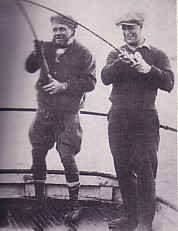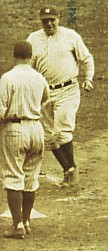|

|
| Fishing, a passion of both men. |
"He walked in the Babe's shadow, as he was to do through all the years that the Babe played in New York," Frank Graham,
Yankee reporter and student of Gehrig, wrote. "But jealousy of the Babe was entirely missing from his make-up - jealousy of
the Babe or, for that matter, of anybody else." Nearly every baseball historian agrees with Graham. But they don't agree on
why the once-strong friendship between the two legends was shredded in the 1930s.
When Gehrig joined the Yankees in 1923 at 20 years old, Ruth was already the idol of every schoolboy. Boy Gehrig was not
exempt. The young'n was awestruck by Ruth. Gehrig's wife, Eleanor, wrote in her autobiography, "Lou admired Babe as a ballplayer.
You had to, he was superb." Eventually Ruth warmed up to the kid, which isn't at all surprising since the two, though years
apart in age, could easily bond over their shared German heritage and their top-seed positions in Murderers' Row. They were
"double jeopardy" to pitchers, as Eleanor put it.
Some historians and players have argued that Gehrig was a more reliable hitter than Ruth (after all, Gehrig batted clean-up,
not Ruth). "I don't even remember [Ruth] ever hitting a double play ball," Charlie Gehringer, Detroit's second baseman during
the Ruth-Gehrig era, said. "He wouldn't hit it hard enough. It'd have that top spin and dribble along. But Gehrig? He'd hammer
'em." Gehrig did, in fact, challenge Ruth in batting numbers. He ranked almost as high or higher than Ruth in RBI, HR, R,
2B, etc., consistently throughout his career.
When their friendship began, Gehrig could not let go of his awe towards Ruth the Great Bambino. In fact, Gehrig once thought
that the most thrilling moment in his career was shaking Ruth's hand as he crossed the plate after hitting number 60 (and
setting the record for most homeruns in a season) in 1927. His undying respect for Ruth the hitter was segue to his lack of
jealousy towards him.
This check in ego allowed many things Ruth got attention for, even when they weren't as important as what Gehrig had done,
slide out of Gehrig's conscious. For instance, in the 1932 World Series, Gehrig out-homered Ruth. But hardly anyone remembers
that. What they do remember is Ruth supposedly "calling his shot." Gehrig was on deck during Ruth's controversial at-bat.
A 35mm home video of the incident clearly shows Ruth pointing, but it's unclear to what or whom he was pointing. The myth
is he pointed to the centerfield bleachers, where he happened to send the next pitch. The reality was Ruth and pitcher, Cubs'
Charlie Root, were throwing words at each other, as both teams had been doing all day. Ruth was pointing at Root, not the
bleachers. Gehrig told the press, "Babe was jawing with Root and what he said was, 'I'm going to knock the next pitch right
down your god-damned throat.'" Root's catcher, Gabby Harnett, denied Ruth called his shot as well. According to him, Ruth
held up two fingers to indicate that he had two strikes on him, then yelled at Root, "It only takes one to hit!"
In the end, Gehrig had out-performed Ruth, but Ruth still got all the attention. As his nature demanded, though, Gehrig
laughed the whole thing off, calling Ruth "that big monkey."
At the time of the supposed called shot, Ruth and Gehrig were still friends. Good friends. Even Mom Gehrig liked Ruth,
constantly cooking for him and playing host to his family. As thanks, Ruth gave Mom a chihuahua which she named "Jidge," a
German-accent twist on "George," Ruth's real name.
By 1934, however, the Gehrigs were no longer hosting the Ruths. The friendship was in tatters. Frank Graham wrote, "There
had been stories of a coolness between him and the Babe and, as a matter of fact, there was truth in them. There was nothing
serious behind this coolness. Simply that in the last two or three years the old friendliness had worn thin. Things had been
said, briefly, thoughtlessly, on both sides."
Richard Bak wrote that the friendship was falling apart because, first, Ruth was close to retirement while Gehrig was in
his prime, and, second, Ruth resented Joe McCarthy's appointment to manager in 1931 when Ruth was rumored to want the position.
Gehrig immensely respected McCarthy, and Ruth knew it.
Yes, it's true stupid things were said on both sides. Yes, it's true Gehrig's prime overlapped Ruth's twilight. It's true
Ruth and Gehrig could not have had more opposite opinions of McCarthy. But the "coolness" was more of an iceberg than Graham
and Bak claim. Gehrig had two particularly vulnerable spots in his heart; one for his wife and one for his mother. Both women
were major causes in the avalanche of the friendship. Gehrig married Eleanor Twitchell in 1933. Shortly after the wedding,
the couple went on an All-Star cruise in the Fall. On the ship, Eleanor went to hang out with Ruth and his wife in their cabin.
She forgot to mention this to Gehrig, who was so worried about his bride that he had a search party scouring the boat and
the water. When someone finally found her, Gehrig was furious - at Ruth. Gehrig was never jealous of Ruth on the field, but
he was scared of his natural charm and power over women, namely Eleanor. Though nothing disreputable happened in the Ruth
cabin, Gehrig could not be convinced that Ruth did not use any influence over Eleanor's primal sentiments.
Meanwhile Gehrig's other "best girl," Mom, was growing more distant from the Ruths. While Mom thought highly of Ruth, his
first wife, and his young daughter Dorothy, she did not care for his second wife, Claire, who Mom thought favored her own
daughter over Dorothy. In 1934, Ruth and Claire went on a trip, leaving Dorothy at home. Dorothy went to the Gehrig house,
as she often did, to hang out. Mom deduced that she had been abandoned, left in sub-par clothes. So, when Claire came to pick
up Dorothy, Mom tore into her. Claire, in turn, told Ruth that Mom was nosing in. Ruth told Gehrig that Mom needed to "mind
her own goddamned business." That was it for Gehrig. From his point of view, Ruth had edged in on his wife, then insulted
his mother. "They were never friends again," said Bill Dickey, teammate and best friend to Gehrig. "You know that famous picture
of Babe hugging Lou when Lou had that retirement ceremony at the stadium in 1939? Well, Babe put his arms around Lou and hugged
him but, if you look close, Lou never put his arm around the Babe. Lou just never forgave him."

|
| Is that a fake smile on Gehrig? |
In 1934 Ruth's power at the plate continued to dwindle while Gehrig's power raged on untarnished. The media,
as expected, played up the turn of the tables and Gehrig inherited the spotlight. He had a difficult time dealing with
the pressure. To encourage his natural instincts, Eleanor wrote a note to her man: "Be yourself. The Babe is one fellow and
you are another and you never can be like him. Don't try. Just go on being as you are - fine and true and simple - and great
in your own right."
He continued being "fine and true and simple;" Ruth struggled for attention and respect.
All said, Gehrig ended up with the reputation as a powerful hitter who was a powerful human being. Those who knew him personally
used adjectives such as modest, humble, true, honest, incredible, dedicated, and great to describe him. Pete Sheehy, longtime
Yankee clubhouse attendant, knew both Gehrig and Ruth well. Sheehy hailed Gehrig as a true hero, and of all the players Sheehy
had met, Gehrig was the one he admired most. Of Bambino, Sheehy said, after a moment of thought, "Ruth never flushed the toilet."

|
| Meeting at the plate after #60 |
|

